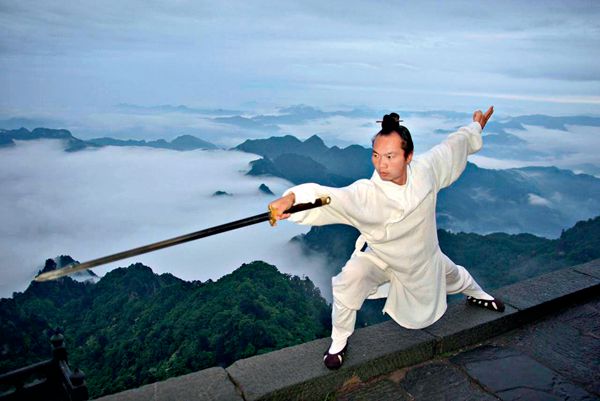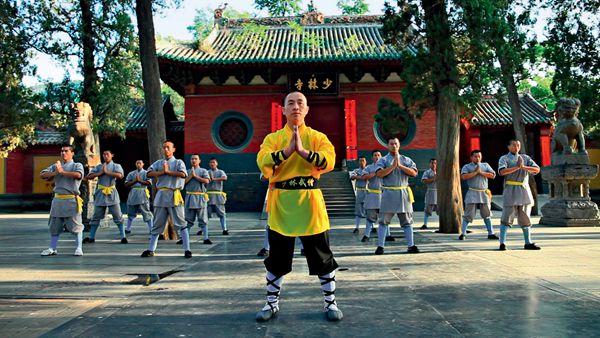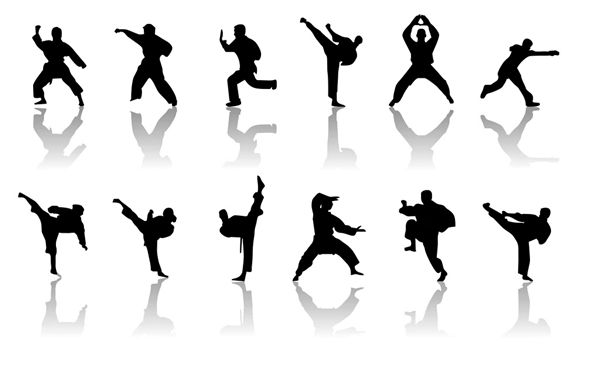Martial Arts
By GU HE
CHINESE martial arts (Kung Fu), or Wushu in Chinese, with its long history and rich culture, have created and passed down numerous legends over millennia and produced generations of heroes.
Martial arts and dancing are virtually synonymous. There exists a legend from primitive times of dancing while carrying a shield and axe. The real historical tale occurred in 206 BC when Xiang Zhuang, cousin of “Hegemon King of Western Chu” Xiang Yu, pretended to perform a sword dance at a palace banquet in an attempt to assassinate his cousin’s rival. Later General Zu Ti (266-321) of the Jin Dynasty (265-420), aspiring to regain lost territory and realize national rejuvenation, was in the habit of rising early in the morning to practice swordplay. At the same time, sword dancing has gradually evolved into a kind of art form. Certain people hold the view that Chinese martial arts are just a kind of showy performance but they in fact imbue concentrated combat methods.

The Wudang Sect represents armed boxing.
The essence of Chinese martial arts lies mainly in “the qi manipulation of the internal body, as well as improving external fitness,” which fully resonates with the Chinese traditional philosophy of “oneness of heaven and man.” The internal and external styles of martial arts were thus formed. “Qi” is variously defined as the inner energy or “life force” said to animate living beings. Zhang Sanfeng (1247-1458), founder of the Wudang Sect, was reputed as the originator of internal boxing which contains Taiji Boxing, Xingyi Boxing, Bagua Boxing and Yongchun Boxing, and is widely known in recent years.
Meanwhile, external boxing, which pays great attention to physical practice, has prevailed over other rivals in terms of power and speed. Among them, Shaolin Boxing is the most prestigious and globally well-known. Jeet Kune Do created by Bruce Lee (1940-1973) also belongs to this external boxing. The pursuit of “qi” brought about the emergence of Qigong (practice of qi), the combination of martial arts and traditional body-building exercises, in the Qing Dynasty (1644-1911). Ming (1368-1644) and Qing dynasties are the thriving period of Chinese martial arts. Many traditional cultures such as philosophy, religions and health maintenance are part of the Chinese martial arts ethos.

Shaolin represents the ultimate martial arts school.
Chinese Wushu has two major categories: Free-hand boxing and armed boxing (swordsmanship in particular). The past 2,000-plus years have seen various forms of boxing, including clinch fighting, hand-to-hand combat, no-holds-barred fighting, xiangpu contests (Sumo), and wrestling.
The theory of using swords came into being as early as the Warring States Period (475-221 BC) when advanced sword forging techniques appeared in southeast China. The Wu-Yue Spring and Autumn Annals recorded a female sword master named Yue Nü, which inspired Louis Zha (Jin Yong), the most popular “martial arts and chivalry” novelist, to write a novelette Sword of the Yue Maiden. The martial arts repertoire had a relatively stable formation in the Song Dynasty (960-1279). “The 18 main weapons,” including broadsword, long spear, sword, halberd and axe, fully developed in the Ming Dynasty.

Chinese martial arts repertoire.
With the cold weapons age, Chinese Wushu entered modernization. In the early 20th century, fearless Huo Yuan Chia (1868-1910) set up the Chin Woo Athletic Federation, which combined sports and martial arts, and became the trend for martial arts practitioners. Since the founding of New China in 1949, especially after the reform and opening-up policy in 1978, traditional martial arts have been reinvigorated and regained more opportunities to enter the world arena. Set pattern and free combat are given equal value, especially free combat. The set pattern is now a competitive event in the Asian Games.
Although Chinese Wushu advances with times, it also meets new challenges. The combination of Chinese “Kung Fu” and film attracts the world’s attention, wherein artistry and commercialization have made it more a performance than a physical exercise. In addition, the Kung Fu trend forces people to seek certain mainstream categories, while some minor traditional schools may lack successors. Chinese martial arts, as an intangible cultural heritage of the Chinese nation, have great potential for promoting people’s physique and quality and need to be fostered. The existing problems shall be paid more attention and gradually solved.
(Selected from Monthly Digest by Zhonghua Book Company)
